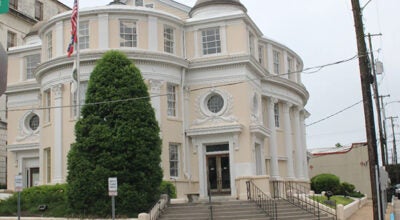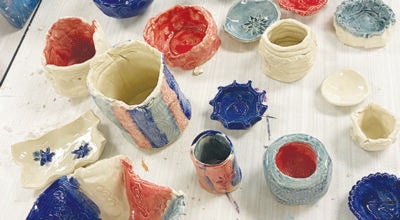SURREAL ART PALACE:
Published 12:00 am Friday, June 23, 2000
Dali museum reflects his mix of stage and studio
FIGUERES, Spain (AP) — Despite the screaming fuchsia paint job, geodesic dome and enormous golden eggs lining the roof, Salvador Dali’s surreal art palace sits inconspicuously next to the parish church where he was baptized in 1904.
The Dali Theater-Museum was the biggest work of the artist’s life, and he’s buried in an unmarked crypt at the center of the main exhibition hall, surrounded by the irrational, incomprehensible and just downright comical.
Dali was born in this northeastern Spanish town of 30,000 and, as he wrote in the “Secret Life of Salvador Dali,” he was provocative from the first heartbeat.
“In one of the houses in Calle de Monturiol a newborn baby is being carefully and lovingly watched over by his parents, causing quite a commotion and no small fuss in the household. Alas! Remember what I am about to say, I won’t be like that the day I die,” he wrote.
Opened in 1974 in a municipal theater bombed during the 1936-39 Spanish Civil War, the setting suits a theatrical artist like Dali, who mixed Hollywood and stage with the studio.
Visitors are welcomed by a well-chromed 1941 black Cadillac with a white convertible top — blaring out opera music from the car’s gearbox and differential unit — parked at the center of a round interior patio.
A few steps away is the No. 1 attraction — the Mae West Room with its voluptuous, ruby-red-lip sofa, a 15-foot-high blond wig and a peephole into Dali’s rendering of her brain: a mussed-up bed overgrown by jungle vines and hovered over by plastic flamingos.
To pull the scene together, climb the stepladder and peer down through a massive magnifying glass planted in the stomach of a stuffed camel on stilts. The Daliseque collage is a spatial interpretation of his famous painting that hangs in the Art Institute of Chicago, “Mae West’s face which may be used as a Surrealist Apartment.”
There are a few guest artists, but 90 percent of the work is Dali’s eccentric creation. There’s kitsch — a gold-plated orangutan skeleton — and many famous works, including the stereoscopic painting featuring his Russian-born wife Gala — “Dali from the back, painting Gala from the back.”
In a canvas dedicated to Catalan philosopher and friend Francesc Pujols — “When it falls, it falls” — Dali’s famous soft clock numbers ooze off the wall and everything else droops, starting with the noses of women and ending with their bread loaves.
Some of Dali’s best-known works are on display, including “Poetry of America,” “Galarina,” “The Basket of Bread,” “Atomic Leda,” “Galeta of the Spheres” and “The Spectre of Sex Appeal.”
Sandwiched between the museum and the parish church of St. Peter is the Plaza de Gala i Salvador Dali, where visitors can sip coffee and contemplate a 40-foot-high tower of 15 stacked-up televisions, the work of German artist Wolf Vostell.
The plaza also is shaded by three truck-tire columns created by Dali, with statues of French artist Ernest Meissonier on top.
A walk around the outside of the museum offers a close-up look at hundreds of golden, three-pointed bread-loaf forms set in relief on the building’s burgundy exterior.
“The museum colors are usually linked to the church — cardinals, popes and the symbols of power,” said museum spokesman Jordi Falgas. “He was religious, conscious of the power of religion, and very much interested in the relation between art and religion. … And all through, the power of the church is a theme.”
Bread — and all kinds of food, for that matter — pop up in much of Dali’s art. “The three-pointed loaves were made in Figueres for a time when he was a kid and the shape stuck in his mind,” Falgas said.
Almost everyone likes the bread heel and Dali, thinking reasonably, figured three heels were better than two.
He was never modest, and always himself.
“At the age of 3, I wanted to be a female cook,” Dali once said. “At 7, Napoleon. After that, my ambition just went on growing. I wanted to be Salvador Dali and nobody else.”
Though the most popular, the museum is only a third of the “Dali Triangle” in northeastern Spain run by the Gala-Salvador Dali Foundation. It’s the fifth most-visited in Spain — after Madrid’s Prado and Reina Sophia, Bilbao’s Guggenheim and Barcelona’s Picasso — attesting to its lure, despite a slightly out-of-the-way location 85 miles north of Barcelona.
The other two Dali landmarks that make up the triangle are within a short drive of Figueres.
To get to know the sea, the light and the olive grove-dotted Pyrenees foothills that inspired Dali, take the hour-long drive east of Figueres that twists into the idyllic Mediterranean fishing village of Cadaques.
A labyrinth assembly of fishing huts in Port Lligat, just a short walk north of Cadaques, served as Dali’s and Gala’s main residence from about 1930 until the early 1980s and it is where he produced most of his famous works.
Dali spent much of his youth in Cadaques, a postcard-perfect fishing port of whitewashed, block houses where his father was born, located only 15 miles from the French border.
Many of his paintings are bathed in Mediterranean light and use the backdrop of the rocky Costa Brava coastline around Cadaques. The house is open to the public, but reservations are suggested (see the “if you go” box).
The third point of the triangle is Gala’s Castle, a medieval fortress 25 miles south of Figueres in Pubol. Dali bought the castle for his beloved wife, and she spent her summers there. When she died in 1982, he took up residence in the castle, where she is buried.
A few months after Gala’s death, depressed and often spending all day in bed, he suffered severe burns over his legs and arms when an electrical bell used to summon nurses short-circuited; the bed and room caught on fire.
Dali painted his last works in the castle, but never returned after the fire. He retired to the Torre Galatea, a part of the main museum in Figueres, where he died in 1989.
“When you see all three places, you see the land that inspired him, the atmosphere, the air that he breathed,” Falgas said. “You are allowed to enter into his world and jump into one of the surreal dreams he paints.”





